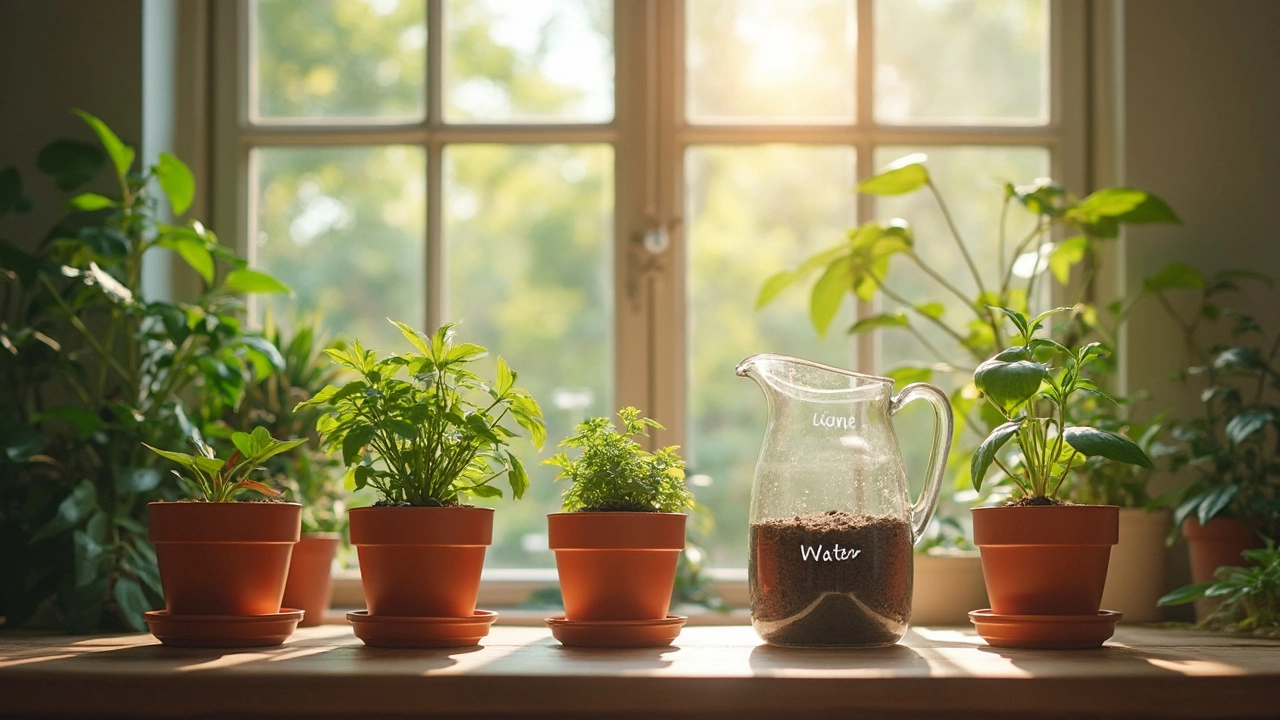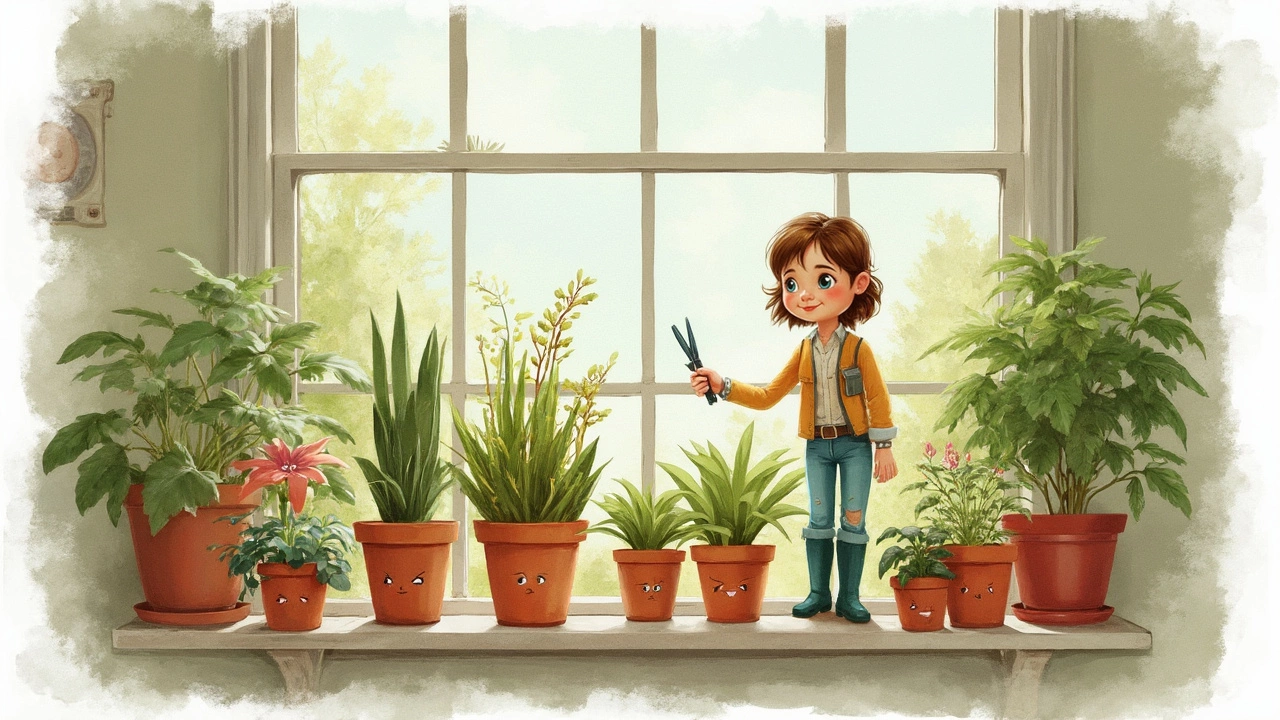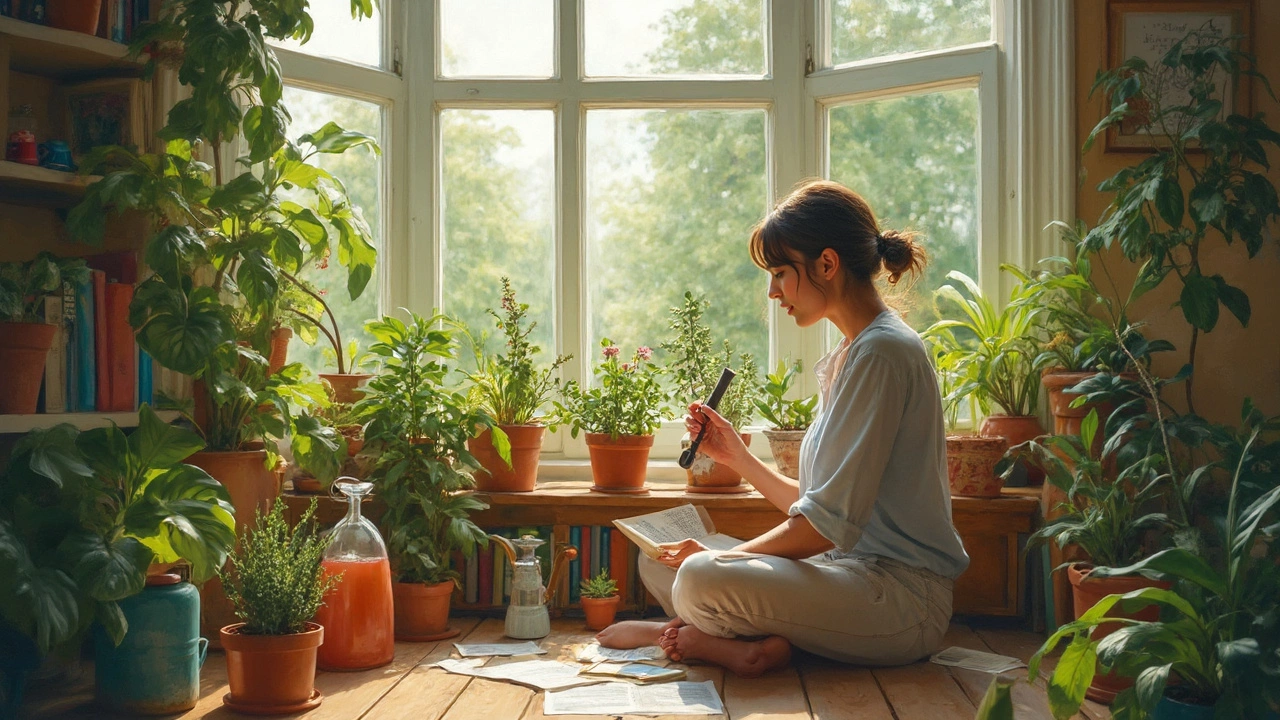Ever brought home a plant, only to watch it slowly droop or drop its leaves for no clear reason? You’re not alone. Most plants don’t die because people don’t care—they die because care is a bit trickier than you’d think. The good news? Keeping indoor potted plants alive is way less complicated once you learn a few basics.
Location is half the battle. Some plants love basking in a sunlit window, while others scorch if they get too much direct light. Knowing what your plant likes can save loads of headaches down the line. If you remember walking through your living room and stopping to notice where the sun hits in the morning and afternoon, you’re already ahead of most people.
- Finding the Right Spot
- Watering Without Guesswork
- Getting Soil and Pot Right
- Feeding and Fertilizing Made Easy
- Troubleshooting Common Problems
Finding the Right Spot
Where your plant sits is honestly make-or-break. Most indoor potted plants fail because they’re stuck in the wrong spot from day one. Before you pick a location, check your plant’s label for sunlight needs—direct, indirect, or low light. Not sure what it wants? Most leafy green houseplants, like pothos, peace lily, and snake plant, prefer bright but indirect sunlight. If you put them on a windowsill that gets blasted by midday sun, you’ll see scorched leaves fast.
Get to know your windows:
- South-facing windows: brightest, best for sun-lovers such as succulents and cacti.
- East-facing windows: gentle morning sun; great for many tropicals and flowering plants.
- West-facing windows: strong late-day sun; good for tougher species, but watch for leaf burn in summer.
- North-facing windows: lowest light; choose low-light plants like snake plant or ZZ plant.
There’s some hard data on how much light plants really get indoors versus outside. Even the brightest indoor spot is about 1/10th the light of full daylight outside—so don’t be surprised if a “sun-loving” plant doesn’t thrive in the middle of your room. Here’s a quick reference:
| Window Direction | Typical Light (lux) | Best For |
|---|---|---|
| South | 10,000 - 25,000 | Succulents, cacti |
| East | 5,000 - 10,000 | Tropicals, ferns |
| West | 8,000 - 15,000 | Philodendron, dracaena |
| North | 3,000 - 5,000 | Snake plant, ZZ plant |
If you have a room with zero natural light, don’t sweat it. Small LED grow lights have gotten cheap and energy efficient, so you can put your indoor plants basically anywhere. Just make sure the light stays on for about 12-14 hours a day. Plants notice when you short-change their daylight, even if you don’t.
Bottom line: look for bright, indirect light for most houseplants. But check each plant’s needs, move them around if they’re not happy, and don’t be afraid to use technology if your place is more cave than greenhouse.
Watering Without Guesswork
Most people kill their indoor plants by watering too much or not enough. The trick is to let the plant, not the calendar, tell you when it needs a drink. Soggy soil is a fast track to root rot, while dry soil means crispy leaves. So, ditch the guesswork.
Your best tool? Your finger. Stick it about an inch into the soil (roughly to your first knuckle). If it feels dry, it’s time to water. If it still feels damp, wait a day or two and check again. That’s way more reliable than watering every Saturday just because it’s the weekend.
Different plants have different thirst levels. For example, snake plants and ZZ plants like to dry out between waterings, but most ferns want their soil to stay just a bit damp. Here’s a cheat sheet with a few classic houseplants and their general watering needs:
| Plant Name | Watering Frequency | Other Notes |
|---|---|---|
| Snake Plant | Every 2-3 weeks | Let soil dry out fully |
| Pothos | Every 1-2 weeks | Soil dries halfway between waterings |
| Peace Lily | Weekly | Soil slightly moist, droops if thirsty |
| Spider Plant | Every 1-2 weeks | Don’t let it sit in water |
Water slowly and deeply. If water runs straight through into the saucer, you probably poured too fast or the soil is too compacted. Always empty the saucer, because roots left in standing water rot fast.
If you ever see wilted leaves but the soil is still wet, stop watering. Your plant is more likely drowning than thirsty. And here’s a fun fact: tap water with lots of salts or chlorine can sometimes hurt sensitive plants. Using filtered water or letting tap water sit out overnight can give them a break.

Getting Soil and Pot Right
We underestimate just how picky some houseplants are about their soil and their pots. Most of the time, those little plastic pots you buy from the store aren’t built for the long haul, and that Miracle-Gro from your garage isn’t the solution to every houseplant problem.
First things first: not all dirt is created equal. Most indoor plants do better with soil that’s made for containers—something you’ll see labeled as “potting mix” or “indoor plant soil” at most stores. This stuff is specially blended to keep water from pooling (which causes root rot), but it still holds enough moisture so the plant doesn’t get thirsty five minutes later. For succulents and cacti, go for a gritty, fast-draining mix; for ferns, look for a richer, more water-retentive option. Generic garden soil is too heavy and can suffocate plant roots indoors.
The pot makes a huge difference too. See those holes at the bottom? They’re not optional. Your plant needs drainage or you’ll end up with swampy, unhappy roots. If you're switching to a decorative pot without a drainage hole, add a layer of pebbles at the bottom, but be aware—it’s not as foolproof as real drainage. Ideally, stick with actual drainage holes for the long-term health of your plant.
Picking the right pot size matters more than you think. A pot that’s too small will crowd the roots; a pot that’s too big can make the soil soggy and cause rot. Here’s a quick tip: when repotting, move up just one pot size (about 2 inches wider in diameter) beyond your plant’s root ball.
| Plant Type | Recommended Soil | Ideal Pot |
|---|---|---|
| Succulents | Cactus/succulent mix | Shallow with drainage |
| Ferns | Moisture-retentive potting mix | Medium/Deep with drainage |
| Snake Plant | Well-draining indoor plant mix | Pot with drainage |
| Pothos | All-purpose potting mix | Standard with drainage |
If you nail the right combo of soil and pot, everything else gets easier. Your indoor plants will thank you by growing faster and dropping fewer leaves—which is really what everyone wants, right?
Feeding and Fertilizing Made Easy
Getting feeding and fertilizing right is where a lot of plant owners trip up. You don’t need a chemistry degree, but you do need to pay attention to what’s actually in the pot. Indoor potted plants only get nutrients from the soil you give them, which runs out after a few months—especially if you’re watering regularly. Without feeding, your plant’s growth will stall, and leaves will look sad, or even turn yellow.
So how do you keep things simple? Use an all-purpose liquid fertilizer for most houseplants. These are easy to mix with water, and you can use them every 4 to 6 weeks during the growing season (spring and summer). Skip fertilizing in winter when most plants slow down. Overdoing it does more harm than skipping it. If you notice brown tips or crispy leaves, back off the fertilizer or dilute it.
Here’s a quick guide for indoor plants to help you nail the feeding schedule:
- All-purpose liquid fertilizer: Good for most leafy or flowering houseplants—mix as directed.
- Cactus and succulents: Use fertilizers labeled especially for cacti; feed less often, about every 2-3 months.
- Orchids: Use orchid fertilizer and stick to the package instructions—they’re picky about food.
- Leafy tropicals (like pothos or monstera): A balanced 10-10-10 or 20-20-20 fertilizer works well every month during spring/summer.
Wondering if you’re feeding too little or too much? Here’s what plants usually show:
| Sign | Possible Cause | What To Try |
|---|---|---|
| Yellow leaves | Under-fertilized, poor soil | Feed with balanced fertilizer once a month |
| Brown tips | Too much fertilizer or salts building up | Flush soil with water, hold back on feeding |
| No new growth | Under-fertilized or out of growing season | Feed if it’s growing season; don’t force it in winter |
Feeding your plants sounds technical, but it gets super easy once you make it part of your routine. Always read the label—plants do better with regular but light feeding, not a big feast all at once. Skip fertilizer in winter unless your plant is still actively making new leaves, which is pretty rare indoors.

Troubleshooting Common Problems
Even when you do most things right, sometimes your plant throws a curveball—brown tips, yellow leaves, or drooping stems out of nowhere. Figuring out the cause early saves you tons of frustration and prevents most issues from getting worse.
One of the classic plant complaints? Yellow leaves. Usually, it's a sign your indoor plants are getting either too much water or way too little. Feel the soil—if it's soggy, let it dry out next time. Bone dry? Give it a good soak, but don’t flood the pot. Overwatering is actually one of the biggest reasons for dying houseplants. According to the University of Georgia Cooperative Extension,
“More indoor plant deaths are caused by overwatering than any other single factor.”So, if in doubt, skip a watering and check back in a day or two.
If your leaves are turning crispy brown at the edges, it could be low humidity or too much fertilizer. In apartments and homes with heat or AC running a lot, dry air zaps moisture from your plant. Try misting it a couple of times a week or set the pot on a tray with stones and water—just make sure the plant pot isn’t sitting in water directly.
Here are some fast fixes for common headaches:
- If your plant looks limp and sad but the soil is moist—move it to brighter light and lay off extra water for a bit.
- Brown spots on leaves? Wipe them gently with a damp cloth. Sometimes dust or dry air is the culprit.
- Droopy, yellowing lower leaves often mean not enough light. Try moving your pot closer to a window or switching to a grow light.
- If you spot weird tiny bugs, like spider mites or whiteflies—rinse leaves in the sink and treat with an insecticidal soap spray until they’re gone.
Stats show how common plant issues stack up:
| Problem | Most Common Cause | % of Indoor Plant Owners Affected |
|---|---|---|
| Yellow Leaves | Overwatering | 42% |
| Brown Edges | Low Humidity | 31% |
| Wilting | Underwatering | 21% |
| Pests | Poor Airflow | 16% |
Don’t panic when you spot something weird. Plants are tough—they usually bounce back fast if you tweak your care routine. Stay patient, keep an eye on your green buddy, and use these tips to handle whatever comes up.
